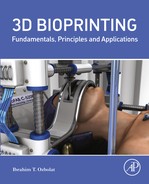The need for hierarchical assembly of three-dimensional (3D) heterocellular tissues has been escalating in medicine and biotechnology. It has spurred the development of new technologies with the ultimate goal of creating de novo functional tissues and organs (
Ozbolat and Yu, 2013). The principal of bioprinting can be defined as the placement of cells within biomaterials into spatially defined structures using automated 3D bioprinter technologies. This process, first named “cytoscribing,” was inspired by classic two-dimensional (2D) paper printers, as the droplets of colored ink are similar in size to biologics (
Klebe, 1988). In the last two decades, various bioprinting processes have emerged along with various process-compatible bioink materials. The process of bioprinting requires a delivery medium for cells which can be deposited into designed shapes acquired from computer-aided design (CAD) models. The CAD models can be generated using 3D medical images obtained through magnetic resonance imaging, computed tomography scanning, and other techniques (
Lee et al., 2014a;
Kucukgul et al., 2015;
Pati et al., 2013). Soft biomaterials loaded with living cells are called bioink and are the “raw material” of bioprinting processes.
The development of bioink materials allows scientists to manipulate biological and biochemical environments as well as living cells to create complex biological constructs. The milestones of success are measured by sustained viability of cells during short- and long-term culture, cell spreading and proliferation, cell–cell and cell–extracellular matrix (ECM) interactions, and functionality of the bioprinted constructs. Although a wide array of biomaterials have been developed for tissue engineering and regenerative medicine (
Furth et al., 2007), the vast majority are not compatible with existing bioprinting technologies. Some important features of an ideal bioink material are bioprintability, high mechanical integrity and stability, insolubility in cell culture medium, biodegradability at a rate appropriate to the regenerating tissue, nontoxicity and nonimmunogenicity, and the ability to promote cell adhesion. In addition, bioink materials should be easily manufactured and processed, affordable, and commercially available. Bioprinted constructs are expected to keep their designed shape and structural strength and integrity, maintain 3D architecture for a defined period of time in vitro, and easily engraft with the host and degrade over time in vivo.
This chapter presents bioink materials used in 3D bioprinting processes including scaffold-based (i.e., hydrogels, microcarriers, and decellularized matrix components), and scaffold-free (i.e., cell aggregates), bioink materials. Limitations and strengths of
each bioink material are elucidated, and their characteristics are evaluated based on several criteria including their compatible bioprinting modalities, bioprintability, biomimicry, resolution, affordability, scalability, practicality, mechanical and structural integrity, bioprinting and postbioprinting maturation times, degradability, commercial availability, immunogenicity, and applications. Finally, the chapter provides the reader with limitations and presents future perspectives of bioink materials.
